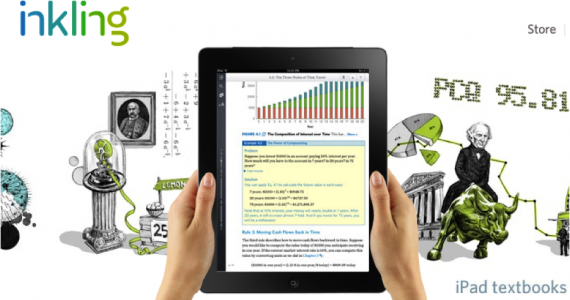This is the third post in a four part series on The Mobile Campus. This series examines how students are using mobile devices and the impact on higher education. To read the first post on student mobile application usage trends click here. To read the second post about location based application Foursquare’s partnership with universities click here.
Backpacks will be a lot lighter this fall when student’s head back to class at some colleges. Inkling, a San Francisco start-up has developed an interactive textbook platform for the iPad. Both universities and investors have taken notice. Publishing companies McGraw-Hill and Pearson are early investors. According to the Association of American Publishers, $4.5 billion worth of textbooks were sold in 2010. The universities already set to use Inkling iPad textbooks this fall include Brown, University of California-Irvine, and the University of Central Florida.
But will they college students use interactive iPad textbooks? Are they interested? Turns out it’s exactly what they want. A July 2011 research study by Kelton Research revealed college students can expect to spend more than $2400 on textbooks before getting a degree and the average student carries 20 pounds of books around campus. According to the same study, 62% of the college student respondents revealed they would spend more time studying if they had either online or mobile access to their textbooks, and 71% of respondents were ready for required reading to be accessible through a mobile or online application. Although there are dozens of mobile tablets on the market, The iPad is the most advanced and popular, making it the perfect platform for interactive textbooks.
When it launched in 2010, Inkling had 4 books for the iPad, but by fall semester there will be over 100 textbooks downloadable within the iPad app. Currently students are able to buy book chapters through the iTunes app store at $2.99 each. Art, business, history, and medical textbooks make up a bulk of Inkling’s catalogue. Users are able to interact in many ways with the textbook – from rotating images, to zooming, to watching imbedded videos. Medical textbooks that show 3D renderings of the heart and other elements of the circulatory system have been receiving rave reviews from medical students.
Inkling is currently the frontrunner in the interactive tablet textbook space, but they certainly have competitors – including CourseSmart, which offers PDF e-textbook services and Push Pop Press, an interactive iPad reading platform which was recently acquired by Facebook. Another competitor Kno has a database of 70,000 textbooks that can be downloaded and read on mobile devices, but they lack the interactivity of Inkling’s iPad offerings.
So what does this mean? One thing is for certain – students will carry fewer textbooks in the coming years. Whether it is Inkling or another company, textbooks will continue to transition onto tablets and other devices that make them more accessible and engaging. As long as digital textbooks meet the needs of students they will dominate the market by 2020. If they make learning easier, more efficient, engaging, and fun, then they will disrupt one foundation of learning.
To learn more about Inkling visit http://www.inkling.com/
To download the application, visit the Apple iTunes store by clicking here.
Incoming search terms:
- mobile text books college
- Aug 7 2011 – The universities already set to use Inkling iPad textbooks this fall include Brown University of California-Irvine and the University of Centra
- colleges using inkling
- mobile app college students campus facilities ipad
- the average student carries pounds of books
- the average college student carries how many books
- university of central florida ipad heart medical
- mobile reading in campus
- mobile learning for 2020
- ipad 2020

